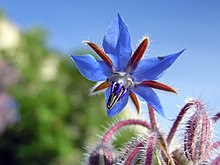
Edible flowers are flowers that can be consumed safely. Flowers may be eaten as vegetables as a main part of a meal, or may be used as herbs. Flowers are part of many regional cuisines, including Asian, European, and Middle Eastern cuisines. [1]

Edible flowers are flowers that can be consumed safely. Flowers may be eaten as vegetables as a main part of a meal, or may be used as herbs. Flowers are part of many regional cuisines, including Asian, European, and Middle Eastern cuisines. [1]



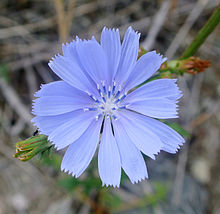

A number of foods are types of flowers or are derived from parts of flowers. The costly spice saffron consists of the stigmas and styles collected from the inside of a type of crocus flower. Broccoli, artichokes, and capers are all technically flower buds, albeit immature forms. [2] Other parts of the plants than the flowers mentioned in this list may be poisonous.
Flowers reported as edible include: [1]

Some flowers are safe to eat only in small amounts. Apple flowers (Malus spp.) contain cyanide precursors, and Johnny jump-ups (Viola tricolor) contain saponins. Borage (Borago officinalis) and daylily (Hemerocallis spp.) flowers are diuretics, and sweet woodruff (Galium odoratum) can have blood-thinning effects. The flowers of linden trees (Tilia spp.) are reportedly "safe in small amounts", but heavy consumption can cause heart damage. Marigolds (Tagetes spp.) can be harmful in large amounts, and only certain species have an appealing flavor. [1]
Toxic flowers are easily mistaken for edible varieties, and unrelated safe and unsafe species may share a common name. Various non-toxic plants can cause severe allergies in some people. Flowers cultivated as ornamental plants for garden use are not intended for use as food. [8]
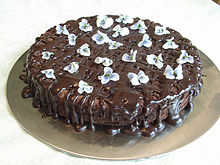
Edible flowers are added to foods to provide flavor, aroma, and decoration. They can be eaten as part of a main dish or be incorporated into salads or cakes. [9] Flowers can be added to beverages as flavorings, or be used to make beverages such as tisanes and wines. They are added to spreads such as butter or fruit preserves, and to vinegar, marinades, and dressings. [1] [8]
Flowers are also consumed for sustenance. [1] Many flowers that are technically edible can be far from palatable. [10] An example of a species with flowers that are of high nutritional value is the dandelion, whose flowers are shown to contain high levels of polyphenols and antioxidants and possess anti-inflammatory and anti-angiogenic properties. [11]
For the best flavor, flowers should be fresh and harvested early in the day. Wilted and faded flowers and the unopened buds of most species can be unpleasant and often bitter. The taste and color of nectar widely vary between different species of flower; consequently, honey may vary in color and taste depending on the species of flower. Many flowers can be eaten whole, but some have bitter parts, such as the stamens and stems. [8]

Kohlrabi, also called German turnip or turnip cabbage, is a biennial vegetable, a low, stout cultivar of wild cabbage. It is a cultivar of the same species as cabbage, broccoli, cauliflower, kale, Brussels sprouts, collard greens, Savoy cabbage, and gai lan.

Broccoli is an edible green plant in the cabbage family whose large flowering head, stalk and small associated leaves are eaten as a vegetable. Broccoli is classified in the Italica cultivar group of the species Brassica oleracea. Broccoli has large flower heads, usually dark green, arranged in a tree-like structure branching out from a thick stalk which is usually light green. The mass of flower heads is surrounded by leaves. Broccoli resembles cauliflower, which is a different but closely related cultivar group of the same Brassica species.
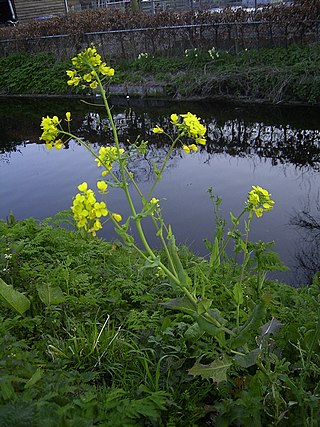
Brassica is a genus of plants in the cabbage and mustard family (Brassicaceae). The members of the genus are informally known as cruciferous vegetables, cabbages, mustard plants, or simply brassicas. Crops from this genus are sometimes called cole crops—derived from the Latin caulis, denoting the stem or stalk of a plant.

Cauliflower is one of several vegetables cultivated from the species Brassica oleracea in the genus Brassica, which is in the Brassicaceae family.
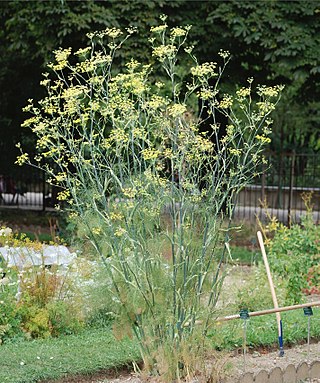
Fennel is a flowering plant species in the carrot family. It is a hardy, perennial herb with yellow flowers and feathery leaves. It is indigenous to the shores of the Mediterranean but has become widely naturalized in many parts of the world, especially on dry soils near the sea coast and on riverbanks.

Root vegetables are underground plant parts eaten by humans as food. In agricultural and culinary terminology, the term applies to true roots such as taproots and tuberous roots as well as non-roots such as bulbs, corms, rhizomes, and stem tubers.
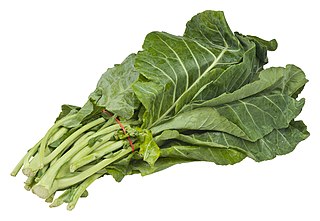
Collard is a group of loose-leafed cultivars of Brassica oleracea, the same species as many common vegetables including cabbage and broccoli. Part of the Acephala (kale) cultivar group, it is also classified as the variety B. oleracea var. viridis.

Brassica oleracea is a plant species from family Brassicaceae that includes many common cultivars used as vegetables, such as cabbage, broccoli, cauliflower, kale, Brussels sprouts, collard greens, Savoy cabbage, kohlrabi, and gai lan.

Leaf vegetables, also called leafy greens, pot herbs, vegetable greens, or simply greens, are plant leaves eaten as a vegetable, sometimes accompanied by tender petioles and shoots. Leaf vegetables eaten raw in a salad can be called salad greens.
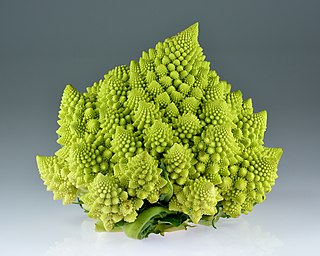
Romanesco broccoli is in fact a cultivar of the cauliflower, not a broccoli. It is an edible flower bud of the species Brassica oleracea, which also includes regular broccoli and cauliflower. It is chartreuse in color, and has a form naturally approximating a fractal. Romanesco has a nutty flavor and a firmer texture than cauliflower and broccoli when cooked.

Verticillium wilt is a wilt disease affecting over 350 species of eudicot plants. It is caused by six species of Verticillium fungi: V. dahliae, V. albo-atrum, V. longisporum, V. nubilum, V. theobromae and V. tricorpus. Many economically important plants are susceptible including cotton, tomatoes, potatoes, oilseed rape, eggplants, peppers and ornamentals, as well as others in natural vegetation communities. Many eudicot species and cultivars are resistant to the disease and all monocots, gymnosperms and ferns are immune.

Taraxacum officinale, the dandelion or commondandelion, is a herbaceous perennial flowering plant in the daisy family Asteraceae. The common dandelion is well known for its yellow flower heads that turn into round balls of many silver-tufted fruits that disperse in the wind. These balls are called "clocks" in both British and American English. The name "blowball" is also used.
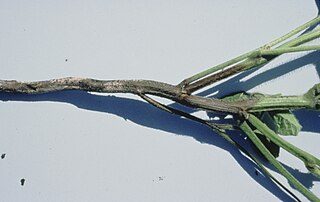
Phytophthora megasperma is a species of water mould in the family Peronosporaceae. It is well known as a plant pathogen with many hosts. It often causes a plant disease called root rot.
Perennial vegetables are vegetables that can live for more than two years.
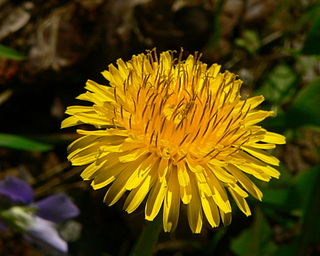
Taraxacum is a large genus of flowering plants in the family Asteraceae, which consists of species commonly known as dandelions. The scientific and hobby study of the genus is known as taraxacology. The genus is native to Eurasia and North America, but the two most commonplace species worldwide, T. officinale and T. erythrospermum, were introduced from Europe into North America, where they now propagate as wildflowers. The plant thrives in temperate regions and can be found in yards, gardens, sides of roads, among crops, and in many other habitats. Both species are edible in their entirety. The common name dandelion is also given to specific members of the genus.

Minerva's Garden is located in the heart of the old town of Salerno, in a zone known as the "Plaium montis" in the Middle Ages. It is halfway along an ideal route that runs along the axis of the walled and terraced vegetable gardens, climbing from the Municipal Park, near the river Fusandola, towards the Arechi Castle.

Spring greens, or spring vegetables, are the edible young leaves or new plant growth of a large number of plants that are most fit for consumption when their newest growth happens in the spring. Many leaf vegetables become less edible as they age and bitter, or potentially even toxic, compounds start to form. Harvesting of spring vegetables is common across Native American cultures.